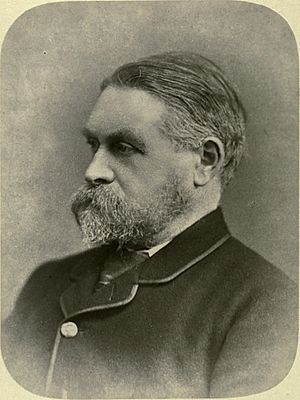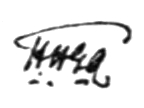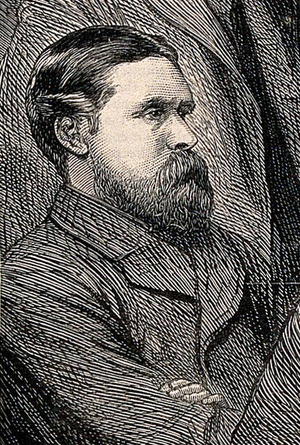Henry Haversham Godwin-Austen facts for kids
Quick facts for kids
Henry Haversham Godwin-Austen
|
|
|---|---|

Godwin-Austen in an image published in 1890
|
|
| Born |
H.H. Austen
6 July 1834 Newton Abbot, England
|
| Died | 2 December 1923 (aged 89) Godalming, England
|
| Citizenship | British |
| Alma mater | Royal Military College, Sandhurst |
| Spouse(s) | Kudidje (1858–1860?); Pauline G. Plowden (1861–1871); Jessie Robinson (1881–1913) |
| Children | 3 |
| Awards | FRS, Founder's Medal of RGS |
| Scientific career | |
| Fields | Topography, surveying, malacology, ornithology, geology |
| Institutions | Trigonometrical Survey of India |
| Author abbrev. (zoology) | Godwin-Austen |
| Signature | |
 |
|
Henry Haversham Godwin-Austen (born July 6, 1834 – died December 2, 1923) was an English explorer, surveyor, and naturalist. He was known for mapping mountains and studying animals. Until 1854, his name was Henry Haversham Austen.
He explored the Himalayas and surveyed the huge ice rivers (glaciers) near K2. K2 is the second-highest mountain in the world. A geographer named Kenneth Mason said Godwin-Austen was "probably the greatest mountaineer of his day." He also studied land snails and slugs in India, becoming a very important expert on them.
Contents
Early Life and Education
Henry Haversham Austen was born in Newton Abbot, England. His father, Robert Austen, was a geologist, a scientist who studies rocks and the Earth. In 1854, his father added "Godwin" to their family name.
Henry's family had a long history of being landowners, soldiers, and scholars. His grandfather was a high-ranking official in Surrey. Henry's mother was the daughter of Major-General Sir Henry Godwin, a famous army officer.
Henry went to the Royal Grammar School, Guildford. From 1848 to 1851, he studied at the Royal Military College, Sandhurst. There, he learned how to survey land for military purposes.
Adventures in Burma and India
In 1851, Henry joined the army. In 1853, he went to Burma (now Myanmar) as an assistant to his grandfather, General Sir Henry Godwin. After his grandfather passed away, Henry's family added "Godwin" to their name.
While in Burma, he mapped the Irrawaddy Delta. His work was noticed by Sir Andrew Scott Waugh, who was the head of surveying in India. In 1856, Godwin-Austen joined the Trigonometrical Survey of India. This group was responsible for accurately mapping the entire country. He began working in Kashmir.
In 1858, Godwin-Austen married Kudidje, a local woman from Poonch. They had a son named Edward. This marriage was seen as legal by local customs. In 1859, Godwin-Austen was injured and went back to England for a year. During this time, he became a member of the Royal Geographical Society.
Mapping the Himalayas
From 1857 to 1860, Godwin-Austen worked on mapping different regions in India. He was given a permanent job with the Survey. In 1860, he mapped parts of Baltistan, a mountainous region.
In 1861, he explored the Karakoram mountains. He surveyed huge glaciers like the Baltoro Glacier and the Biafo Glacier. On this trip, he climbed high up the Baltoro Glacier. He was the first to figure out the exact height and location of K2.
After 1860, Kudidje is no longer mentioned in records, and Godwin-Austen arranged for their son Edward to be adopted. It is thought that Kudidje may have passed away. Years later, Godwin-Austen remembered her fondly, saying she was a "good wife."
In 1861, Godwin-Austen married Pauline Georgiana. They had a son named Alfred, who sadly died very young. Pauline herself passed away in 1871, leaving one son, Arthur.
In 1862, Godwin-Austen mapped more areas, including the Pangong range. He wrote about his findings in Notes on the Pangong Lake District of Ladakh (1864).
Studying Nature
Even though he focused on geology and mapping, Godwin-Austen was very interested in collecting snails and slugs (non-marine molluscs) and identifying birds. He wrote Birds of Assam (1870–1878). He also described many new bird species, sometimes working with another scientist, Arthur Hay. He often drew pictures of the new birds he found.
After 1863, he became very active in studying birds. He was part of a mission to Bhutan and surveyed the Garo Hills and Khasi Hills. He also joined an expedition into the Daphla Hills. He even studied the customs of the Khasi people.
Later Life and Discoveries
In 1877, Godwin-Austen retired from the Survey of India because his health was not good. He was a Lieutenant Colonel when he retired. Back in England, he got better. In 1881, he married Jessie Robinson. She was 20 and he was 47. They were married until she died in 1913. Their marriage was described as full of "love and mutual support."
When his father died in 1884, Godwin-Austen inherited a large house and land in Shalford, Surrey. However, the land did not make enough money to keep up the house. He eventually had to sell the house. After that, he lived in another property on the estate called Nore House.

Godwin-Austen wrote many research papers about the land snails and slugs he collected in India. He sold his collection to the Natural History Museum, London. He continued to work on these collections, describing not just the shells but also the inside parts of the animals. This was important because it helped scientists tell different species apart.
He wrote a major work called The Land and Freshwater Mollusca of India. This book was published in many parts from 1882 to 1920. His research brought him recognition. He was president of the Malacological Society of London (which studies molluscs) and the Conchological Society of Great Britain and Ireland (which studies shells). He was also a vice president of the Zoological Society of London. In 1880, he became a member of the Royal Society, a very important scientific group. In 1910, he received the Founder's Medal from the Royal Geographical Society.
He passed away on December 2, 1923, at Nore.
Beliefs and Legacy
It is believed that Godwin-Austen became a Buddhist. He may have been the first known British person to follow Buddhism. He had a small Buddhist shrine at his home in Surrey. This shrine was likely built around 1901. It might be the first building made for Buddhist worship in Britain. This shrine was forgotten for many years until it was found again in 1962 by actor Dirk Bogarde.
Lasting Impact
The second-highest mountain in the world, K2 in the Karakoram range, was once called Mount Godwin-Austen in his honor. The Godwin-Austen Glacier was also named after him.
Godwin-Austen is considered the most important person to study Indian molluscs. His book, The Land and Freshwater Mollusca of India, is a very important work for studying land molluscs in India and other parts of Asia and Africa. Several types of molluscs, like Austenia and Godwinia, and some Indian species, are named after him. Two types of lizards, Pachydactylus austeni and Pseudocalotes austeniana, also have his name.
His son, Edward, became a civil engineer in India. Edward had fifteen children. Godwin-Austen's nephew, Sir Alfred Godwin-Austen, was a general in the British army during World War II.
Selected Publications
- Notes on the Pangong Lake District of Ladakh (1864)
- Birds of Assam (1870–1878)
- Land and freshwater mollusca of India, including South Arabia, Baluchistan, Afghanistan, Kashmir, Nepal, Burma, Pegu, Tenasserim, Malaya Peninsula, Ceylon and other islands of the Indian Ocean (published in parts, 1882–1920)
See also
 In Spanish: Henry Haversham Godwin-Austen para niños
In Spanish: Henry Haversham Godwin-Austen para niños


